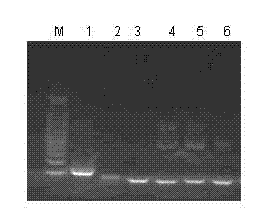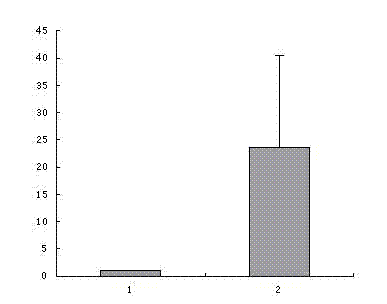In-vitro inducing method for high-expression Nurrl gene of human mesenchymal stem cell
A quality stem cell, high expression technology, applied in the field of stem cell induction, to achieve the effect of convenient material acquisition and easy in vitro expansion
- Summary
- Abstract
- Description
- Claims
- Application Information
AI Technical Summary
Problems solved by technology
Method used
Image
Examples
Embodiment 1
[0030] 1. Induction
[0031] (1) Take the P4 generation umbilical cord mesenchymal stem cells, when the cells adhere to the wall and grow to 80%-90% confluence, remove the original culture medium in the culture bottle, and take 10 mL 0.01M phosphate buffered saline (phosphate buffered saline, PBS) Gently add T 75 Wash in the culture bottle and discard the washing solution;
[0032] (2) Add 1.0 mL of 0.25% trypsin-0.01% ethylenediaminetetraacetic acid (ethylenediaminetetraacetates, EDTA) digestion solution, soak to cover the bottom of the bottle, observe under an inverted microscope that the cells are round and floating, add 1.0 mL of fetal bovine Serum suspended trypsinization;
[0033] (3) Add 10 mL of 0.01 M PBS to repeatedly blow and wash, and centrifuge at 1000 rpm for 5 minutes at room temperature; after discarding the supernatant, add 10 mL of DMEM / F-12 to resuspend the cells, 25 Inoculate 5×10 5 Personal umbilical cord mesenchymal stem cells;
[0034] (4) The cultu...
Embodiment 2
[0039] 1. Induction
[0040] (1) Take the P4 generation umbilical cord mesenchymal stem cells, when the cells adhere to the wall and grow to 80%-90% confluence, remove the original culture medium in the culture bottle, and take 10 mL 0.01M phosphate buffered saline (phosphate buffered saline, PBS) Gently add T 75 Wash in the culture bottle and discard the washing solution;
[0041] (2) Add 1.0 mL of 0.25% trypsin-0.01% ethylenediaminetetraacetic acid (ethylenediaminetetraacetates, EDTA) digestion solution, soak to cover the bottom of the bottle, observe under an inverted microscope that the cells are round and floating, add 1.0 mL of fetal bovine Serum suspended trypsinization;
[0042] (3) Add 10 mL of 0.01 M PBS to repeatedly blow and wash, and centrifuge at 1000 rpm for 5 minutes at room temperature; after discarding the supernatant, add 10 mL of DMEM / F-12 to resuspend the cells, 25 Inoculate 5×10 5 Personal umbilical cord mesenchymal stem cells;
[0043] (4) The cultu...
Embodiment 3
[0048] 1. Induction
[0049] (1) Take the P4 generation umbilical cord mesenchymal stem cells, when the cells adhere to the wall and grow to 80%-90% confluence, remove the original culture medium in the culture bottle, and take 10 mL 0.01M phosphate buffered saline (phosphate buffered saline, PBS) Gently add T 75 Wash in the culture bottle and discard the washing solution;
[0050] (2) Add 1.0 mL of 0.25% trypsin-0.01% ethylenediaminetetraacetic acid (ethylenediaminetetraacetates, EDTA) digestion solution, soak to cover the bottom of the bottle, observe under an inverted microscope that the cells are round and floating, add 1.0 mL of fetal bovine Serum suspended trypsinization;
[0051] (3) Add 10 mL of 0.01 M PBS to repeatedly blow and wash, and centrifuge at 1000 rpm for 5 minutes at room temperature; after discarding the supernatant, add 10 mL of DMEM / F-12 to resuspend the cells, 25 Inoculate 5×10 5 Personal umbilical cord mesenchymal stem cells;
[0052] (4) The cultu...
PUM
 Login to View More
Login to View More Abstract
Description
Claims
Application Information
 Login to View More
Login to View More - R&D
- Intellectual Property
- Life Sciences
- Materials
- Tech Scout
- Unparalleled Data Quality
- Higher Quality Content
- 60% Fewer Hallucinations
Browse by: Latest US Patents, China's latest patents, Technical Efficacy Thesaurus, Application Domain, Technology Topic, Popular Technical Reports.
© 2025 PatSnap. All rights reserved.Legal|Privacy policy|Modern Slavery Act Transparency Statement|Sitemap|About US| Contact US: help@patsnap.com


